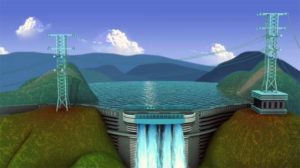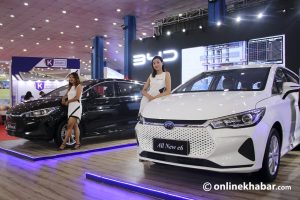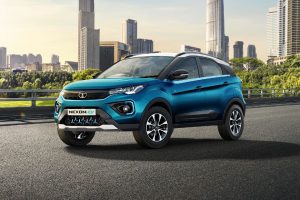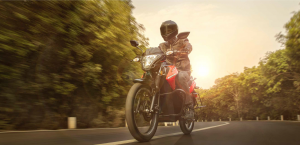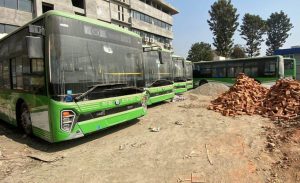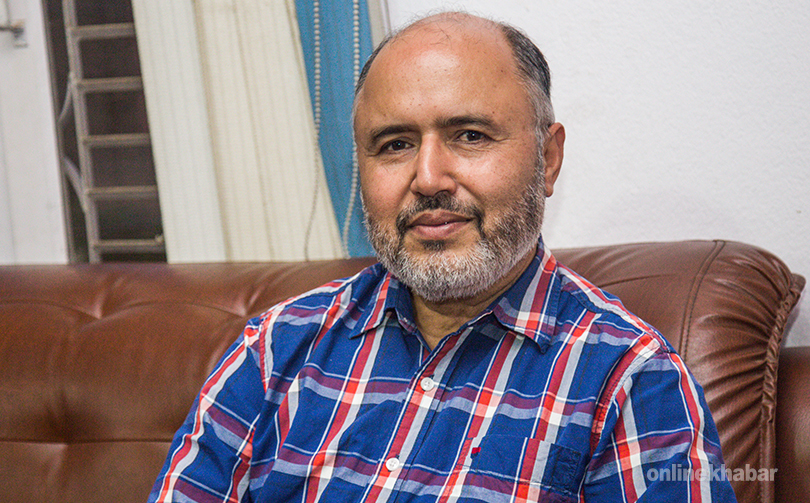
When it comes to electric vehicles, former finance secretary Rameshore Khanal has a unique experience. He was not only one of the people to recommend tax rate cuts on the import of electric vehicles, Khanal is a proud owner of an electric car himself. Onlinekhabar’s Abhaya Raj Joshi recently talked to Khanal about the challenges Nepal faces in completing the transition. Excerpts:
Could you tell us why did you decide to buy an electric car?
Well, during my long career as a bureaucrat, I held various positions. During the last 25 years of my service, I was given different types of cars by the government, for official use. When I resigned from my government job, I started teaching. During the first few years, I would walk to college, but soon, I had problems with my legs. Then I started travelling by bus, but I faced more problems there. There were times where I would not get to sit, and there were times when I became a victim of pickpocketing. It was then that I started borrowing cars from my relatives, including my wife. But that could not go on forever, so I decided to buy a car.
I knew that owning a petrol-powered car has its own cost. So I was looking for an alternative. I looked up alternatives to fossil-fuelled cars on the internet and found that an electric car was what I wanted. While owning a petrol-powered car is cash-intensive–you need cash to do everything, the bill for the power that the car consumes can be paid at the end of the month.
Similarly, I also learnt that I could save more than Rs 100,000 every year on my fuel bill if I bought an electric car. I worked out the math and found that on an electric car, I could get 1 km on just Rs 1.2 while on a petrol car, the same distance would cost be around Rs 12-13. In addition to that, for an electric car, I would not have to worry about the spare parts and the lubricants.
Having driven a car on Kathmandu’s roads for a long time, I knew that with slow-moving traffic, I needed a car that had above average torque. If I bought a car with low torque, my car would be at risk of being bumped from behind. I found the car I needed in KIA Soul. In addition to the economic advantage, there were other advantages: the car is non-polluting and it is rather more intelligent than the petrol car.
During my years on the road, I have observed that most road accidents in Nepal happen because drivers do not realise when their tyre does not have enough pressure. When the tyre does not have enough air and the vehicle is speeding, there is an increased risk of an accident. But in an electric car, there are various sensors that alert the driver when the tyre pressure is low. That helps reduce accidents.
That is why there are numerous benefits associated with electric vehicles.
Despite the long list of benefits, why do you think car owners in Nepal are hesitant to buy electric vehicles?
In my understanding, there are four main reasons why Nepali car owners are hesitant to buy electric cars. Let me go through the reasons one by one.
First, it’s all about perception. During the 90s, we saw the introduction of Safa Tempo in Kathmandu. The three-wheeler public vehicle uses a lead-acid battery and it has been seen to be very slow. Many people blame the vehicle for traffic congestion in the city. So, there are many people who think about Safa Tempo when we talk about EVs. The vehicle’s image is not particularly positive. Battery technology has evolved a lot since the Safa Tempo days, but many people do not know that. They believe that EVs are slow and they do not have the acceleration needed in cities like Kathmandu.
Second, many people understand that Nepal does not have a good charging network for EVs around the country. They believe that their mobility will be restricted to Kathmandu if they rely on electric cars. They feel that they will need an additional petrol car to go out of Kathmandu.
So are you really limited to Kathmandu with your car?
Well, I am not. After fully charging my car, I can drive 200 km. On most of Nepal’s highways, the maximum speed you can drive at is around 60 km/hr. In reality, it will take at least six hours to cover 200 km. According to international norms, a driver should not drive continuously for more than six hours. So even if your electric car gave you extra distance, you would not drive more than 200 km at one go in Nepal. What I do is, drive around 200 km and stay the night in a hotel, where I ask the staff to plug in my car to the mains. When I am resting, my car gets charged, and in the morning I am ready to go.
The 200 km range is quite good for drivers in Kathmandu as you can easily drive to cities such as Pokhara and Janakpur. The other thing with electric cars is that they have abundant space for electronics. In conventional cars, the engine heats up and there is limited scope for various kind of sensors, which make driving safer.
Let’s get back to the third challenge EVs face in Nepal.
The third issue EV owners face in Nepal is that the government has not yet chosen the charging standard for electric cars. Charging stations are coming up in different parts of the country, but the standards are different. For example, a charging station run by a Chinese company is of no use for an EV made in India, they are simply not compatible with one another. Different regions around the world have adopted different standards. For example, in Japan, the standard is called CHAdeMO. The standard is also widely used in the US. Tesla, meanwhile, has a super-charger which is very fast. In Europe, the standard is called SAE Combo. The government needs to choose one standard so that EV owners can charge their cars wherever they see a charging station in Nepal. This will encourage them to switch to EVs.
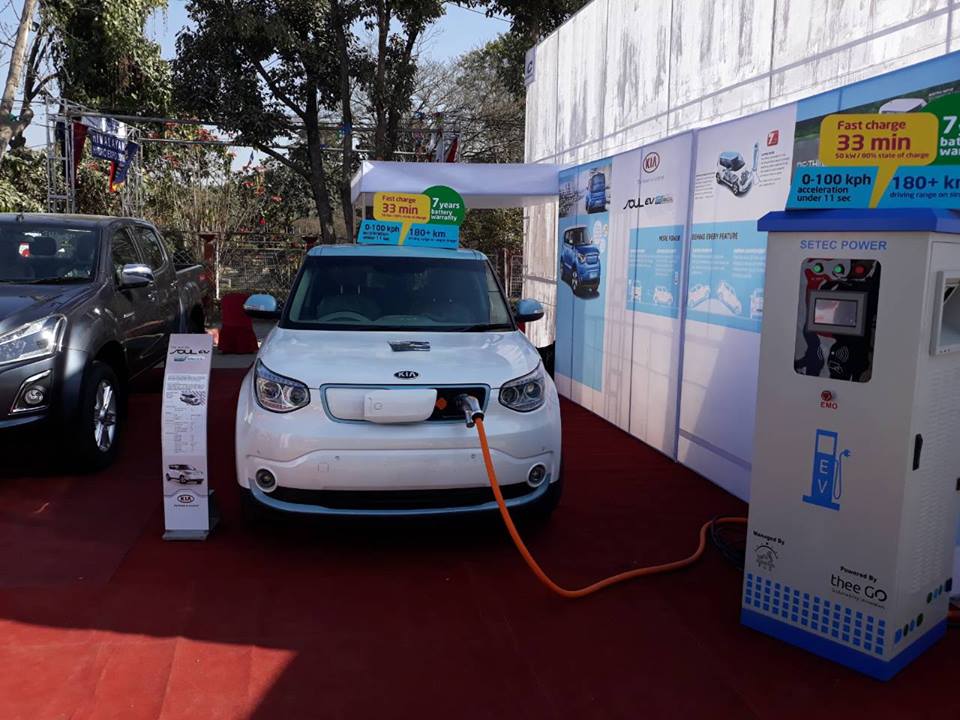
In countries such as Norway and Japan, two countries where EV sales have taken off, the government has either invested in charging stations or required someone to put in the money.
In Nepal also, the government should either do it itself or make it mandatory for others to do it.
In Nepal also, the government should either do it itself or make it mandatory for others to do it. In a country where the top two imports are petroleum and vehicle spare parts, EVs can really help save valuable foreign exchange.
I believe that ultimately, a day will come when petrol stations across the country will see their business plummet. So my suggestion is that the government should make it mandatory for all petrol pumps in Nepal to set up a charging station for EVs. This will be a good investment as eventually, EVs will become the norm in Nepal. A fast charger costs around $ 25,000–this is an amount entrepreneurs here can easily invest.
Now let’s talk about the fourth challenge.
The fourth challenge, as I see it, is the condition of roads in Nepal. Most electric vehicles have lower ground clearance compared to conventional cars. This has to do with the aerodynamics of the car. Manufacturers around the world want to get the most power out of their battery and they are designing their vehicles in such a way that it offers the least resistance to wind. Electric cars, in general, are heavier and designers have no choice but to lower the ground clearance. Driving around with a low-clearance car in Nepal is a big challenge as most of the roads are not smooth.
That is why in China, the government ran a campaign to concretise all its roads in the lasts five years. That has helped them get more EVs on the road.
There are those who say that the price of EVs needs to come down. EVs cost three times more in Nepal than in India. Is it due to the government taxes?
In Nepal, when you import EVs for public transport, you need to pay a 1 per cent import tax. But when you import an EV for personal use, you need to pay 10 per cent tax, which I believe is quite reasonable. Earlier, the rate stood at 50 per cent. In addition to that you need to pay 13 per cent in VAT and an additional 3.5 per cent as road maintenance tax. So, at the end of the process, you pay around 28 per cent tax.
The tax rate for conventional vehicles is around 248 per cent. When the government was preparing its budget two years ago, I had advised the finance minister [Bishnu Paudel] to bring down the import tax on EVs to 20 percent for the existing 50 per cent, but he wanted to go that extra mile and he slashed it to 10 per cent. That is why I think, tax policies on EVs are up to the mark in Nepal.
So, what else can be done to promote EVs in Nepal?
I don’t think we need be more liberal with the taxes or the bank financing schemes–currently, the banks provide up to 90 per cent financing on EVs. I believe that the government should disincentivise the use of fossil fuel cars. For example, it can declare certain areas in the country, especially rural areas recently connected with the national road network, as ‘EV only zone’. It could also declare Singha Durbar, the administrative hub of the country as ‘EV only zone’. Cab owners need to renew their permits every year by paying a fixed fee, why doesn’t the government waive the provision for EVs?
The government, however, needs to cut taxes on the import of batteries. It should also encourage assembly in Nepal.
In India, the government has said it wants to phase out the sales of fossil fuel vehicles by 2030. Is it possible for Nepal to set a date for the transition?
My understanding is that the transition in Nepal will be quicker than in India. As we speak, Nepal already has more charging stations per capita than India. We already have around 35 charging stations in the country. We only have around 2.7 million private vehicles and most of the vehicles owners buy new cars and motorcycles every 5-10 years. When there is disincentive to buy petrol-fuelled cars, people will readily buy EVs. The other difference between Nepal and India is that in Nepal, there has been a voluntary adoption of EVs, even when enough incentives are not been in place.
I would also like to add that EVs will provide a measure of energy security for Nepal. As of now, the price of oil affects us in many ways, but when we switch to electric, the situation will be different. Experience from other markets shows that the cost of energy will continue to decline in the future and we will have surplus electricity soon. The price per unit of hydropower will also gradually fall as production becomes more efficient. That will also contribute to making EVs more viable.
Having said that, do you think automobile sellers in Nepal stand to lose their business because of the switchover?
Globally, it has been seen that automakers earn more by selling spare parts, such as clutch plates and gearboxes, than by selling new cars. In the case of electric cars, the spare parts game is totally different. EV owners do not need to change spare parts frequently and this has an impact on car makers who rely on spare parts sales for their revenue. Fortunately, in the case of Nepal, only a few sellers have a stock of spare parts. Other dealers import spare parts whenever it is necessary. However, there are other independent spare parts dealers in the country who will definitely lose their business.
By when do you think Nepal can make the transition to EVs?
With the right policies in place, we can do it in 10 years. The transition for public vehicles will take longer but for private vehicles, we can do it in 10 years.
This interview is part of a series on E-mobility in Nepal and India produced under a grant from Clean Energy Wire (CLEW), Germany.




